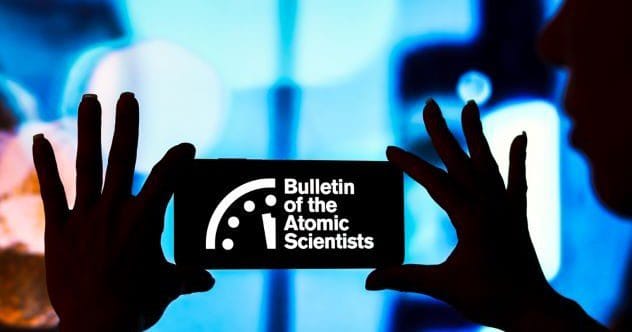Have you ever wondered how close humanity is to a global disaster? Enter the Doomsday Clock, a symbolic timepiece that has been ticking since 1947. Created by scientists, including Albert Einstein, it represents our proximity to Armageddon. With the clock recently moving to a chilling 90 seconds to midnight, its closest point ever, understanding this powerful symbol is more crucial than ever. Let’s delve into ten essential things you should know about the Doomsday Clock.
10 The Origin Story of the Doomsday Clock
Imagine a clock that doesn’t tell time, but instead shows how close humanity is to self-destruction. That’s the Doomsday Clock. It’s not a physical timepiece you’d hang on your wall, but a powerful symbol created in 1947 by the Bulletin of the Atomic Scientists. Many of these scientists, including the brilliant Albert Einstein, had worked on the Manhattan Project, which developed the atomic bomb. However, they were deeply concerned about the potential misuse of such devastating weapons.
The Bulletin was formed by these concerned minds, and they decided the clock would be their way of communicating global threats. Each year, they update its hands. Initially, the clock focused on the looming danger of nuclear war, especially during the tense Cold War era between the USA and the Soviet Union. Over time, its scope has widened to include other global challenges. If you’re curious, a physical representation of this iconic clock is housed at the University of Chicago.
9 Understanding Our Apocalyptic Anxiety
The move to 90 seconds before midnight wasn’t a random decision. It reflects a deeply unsettling period in global events. We’ve seen frightening exchanges of nuclear threats, like those between former U.S. President Trump and North Korea’s Kim Jong-un. More recently, the conflict in Ukraine has raised serious concerns, with military leaders openly discussing the possibility of wider confrontations.
In this tense atmosphere, the Doomsday Clock acts as a stark reminder of the ever-present danger of nuclear war. Midnight on this symbolic clock represents global catastrophe. Rachel Bronson, who leads the Bulletin of the Atomic Scientists, put it plainly: “We are living in a time of unprecedented danger, and the Doomsday Clock time reflects that reality.” She emphasized that setting the clock so close to midnight was a grave decision, urging leaders to use every available channel for dialogue to try and “turn back the Clock.”
8 Why Single Events Don’t Immediately Change the Time
It’s a common misconception that one major global event, good or bad, will instantly cause the Doomsday Clock’s hands to move. That’s not quite how it works. For instance, the tragic September 11, 2001 attacks didn’t lead to an immediate adjustment. However, the broader context of rising terrorism and the U.S. considering leaving the Anti-Ballistic Missile Treaty did contribute to the clock moving closer to midnight, from nine to seven minutes, the following year.
Similarly, the nail-biting Cuban Missile Crisis in 1962 didn’t cause an instant shift. Instead, its aftermath, which included a new treaty limiting atmospheric nuclear tests, actually led to the clock being moved backward, away from midnight. The Bulletin looks at sustained trends and the overall global landscape, not just isolated incidents.
7 New Dangers: Artificial Intelligence Joins the List
The Bulletin of the Atomic Scientists doesn’t just worry about nuclear bombs anymore. They’ve identified a range of modern threats, including the rapid advancement of artificial intelligence (AI). Other concerns include the accidental release of dangerous pathogens from labs and the spread of zoonotic diseases like Ebola – risks that threaten all of humanity. The COVID-19 pandemic certainly highlighted the urgent need for better pandemic preparedness.
Prominent figures in technology and science, such as Elon Musk and the late Stephen Hawking, voiced their concerns back in 2017. They signed an open letter urging the United Nations to ban autonomous weapons – those that humans don’t have meaningful control over. Their warning was stark: an AI arms race could pose dangers even greater than many weapons of mass destruction.
6 Adding Climate Change to the Doomsday Calculation
It took a decade of careful consideration, but in 2008, the Bulletin officially added climate change to the list of factors influencing the Doomsday Clock. They pointed to the serious, planet-wide dangers of rising global temperatures, alongside other technological and life science advancements. The threat of climate change has only become more pressing.
Recent geopolitical events have complicated matters. For example, Russia is a major producer of natural gas and oil. The conflict in Ukraine led to a rush, particularly in Europe, to find alternative energy sources. This ongoing demand for fossil fuels contributed to global carbon dioxide emissions reaching a new high in 2022, after a dip during the COVID-19 pandemic.
5 A History of Shifts: 25 Resets and Counting
When the Doomsday Clock was first unveiled in 1947, its hands were set at seven minutes to midnight. Since that initial setting, it has been adjusted a remarkable 25 times. Eight of these resets moved the hands backward, signaling a decrease in global threats, while seventeen moved them forward, indicating heightened danger. The furthest the clock has ever been from midnight was 17 minutes, a moment of optimism in 1991. In stark contrast, its closest point is the current 90 seconds, set in January 2023.
Interestingly, the Bulletin’s decisions to move the clock’s hands haven’t been tied to specific political administrations in the United States. It has shifted both towards and away from midnight under both Republican and Democratic leadership, reflecting a non-partisan assessment of global risks.
4 When Hope Prevailed: The Furthest from Midnight
The Doomsday Clock isn’t always about doom and gloom; its hands can also move backward, indicating a safer world. The most optimistic setting occurred in 1991, when the hands were moved to a record 17 minutes away from midnight. This significant shift reflected the surge of confidence following the end of the Cold War. In fact, the minute hand was moved so far back that it went beyond the usual depiction of the clock face!
This “best of times” moment symbolized a collective sigh of relief after 45 tense years without a direct nuclear conflict between the United States and the Soviet Union. Sadly, this period of relative peace was short-lived. By the early 2000s, the Bulletin warned of a “new nuclear age,” and the clock began its ominous tick closer to midnight once more.
3 Perilous Moments: The Worst Times Before Now
While today’s 90 seconds to midnight is the closest we’ve ever been, there have been other incredibly tense periods. Before our current era, 1953 held the record for proximity to disaster, when the clock was set at just two minutes to midnight. This alarm was sounded after both the U.S. and the Soviet Union successfully tested powerful hydrogen bombs (H-bombs) within nine months of each other.
Another deeply worrying time was 1949. The Bulletin moved the clock to three minutes to midnight (11:57) when the Soviet Union conducted its first atomic bomb test, drastically changing the geopolitical landscape. These moments served as grave warnings. Thankfully, diplomatic efforts in the late 1950s helped to ease tensions, and by 1963, the clock was moved back to a relatively safer 12 minutes from midnight.
2 What If the Clock Strikes Midnight?
The scientists at the Bulletin always stress that the Doomsday Clock is a call to action. Its movements are meant to alert us to current dangers, not to provide a fixed prediction of our future. But the question naturally arises: what if the hands actually reach midnight? Midnight on the Doomsday Clock signifies an unimaginable global catastrophe.
This could mean the outbreak of a devastating nuclear war, an unstoppable biosecurity crisis, a complete collapse of cybersecurity, or irreversible and catastrophic climate change. If such an event were to occur, it’s a grim thought, but there likely wouldn’t be anyone left to update the clock or report that it had struck the fateful hour.
1 Ninety Seconds from Disaster: Where We Stand Today
The Bulletin of Atomic Scientists announced the historic shift to 90 seconds to midnight citing a confluence of grave threats. A primary driver was Russia’s invasion of Ukraine and the heightened risk of nuclear escalation. However, this alarming decision was also influenced by the worsening climate crisis and the erosion of global norms and institutions designed to mitigate dangers from advanced technologies and biological threats, such as recent pandemics.
The Bulletin also pointed to the expanding nuclear capabilities of countries like China, North Korea, Iran, and India. The persistent increase in carbon dioxide emissions and the growing frequency of extreme weather events underscore the escalating climate threat. Furthermore, infectious diseases, biosecurity vulnerabilities, and the perilous spread of “cyber-enabled disinformation” which undermines democracy, all contributed to this dire assessment. We are, quite literally, 90 seconds from midnight – a stark warning that time is running out to prevent global catastrophe.
The Doomsday Clock is more than just a symbol; it’s a serious reflection of the challenges our world faces. From nuclear proliferation and climate change to the unchecked rise of new technologies, the threats are complex and interconnected. Understanding these ten facts about the Doomsday Clock helps us grasp the urgency of our current situation. While 90 seconds to midnight is a terrifying prospect, the clock’s purpose has always been to spur action and dialogue. It’s a reminder that the future is not yet written, and collective effort can still turn the hands away from disaster.
What are your thoughts on the Doomsday Clock’s current setting? Do you believe we can turn back the time? Share your opinions and insights in the comments below!










